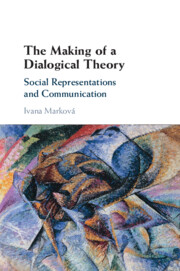Book contents
- The Making of a Dialogical Theory
- The Making of a Dialogical Theory
- Copyright page
- Contents
- Figures
- Acknowledgements
- Introduction
- Part I The Development and Diversification of the Theory of Social Representations and Communication
- Chapter 1 Socio-political Sources of the Theory of Social Representations
- Chapter 2 A Political Refugee in Paris
- Chapter 3 The ‘Age of Intellectual Innocence’ in Psychoanalysis (1961)
- Chapter 4 The Durkheimian in Psychoanalysis (1976)
- Chapter 5 The ‘Great Smoky Dragon’
- Chapter 6 Pseudo-dialogues and Building Bridges
- Part II The Dialogical Perspective of the Theory of Social Representations and Communication
- Afterword
- References
- Index
Chapter 4 - The Durkheimian in Psychoanalysis (1976)
from Part I - The Development and Diversification of the Theory of Social Representations and Communication
Published online by Cambridge University Press: 22 June 2023
- The Making of a Dialogical Theory
- The Making of a Dialogical Theory
- Copyright page
- Contents
- Figures
- Acknowledgements
- Introduction
- Part I The Development and Diversification of the Theory of Social Representations and Communication
- Chapter 1 Socio-political Sources of the Theory of Social Representations
- Chapter 2 A Political Refugee in Paris
- Chapter 3 The ‘Age of Intellectual Innocence’ in Psychoanalysis (1961)
- Chapter 4 The Durkheimian in Psychoanalysis (1976)
- Chapter 5 The ‘Great Smoky Dragon’
- Chapter 6 Pseudo-dialogues and Building Bridges
- Part II The Dialogical Perspective of the Theory of Social Representations and Communication
- Afterword
- References
- Index
Summary
4. The aim of this chapter is to reflect on some crucial differences between the first and second editions of Psychoanalysis. Moscovici wrote the first edition during his ‘age of intellectual innocence’ when he knew only a little of Durkheim’s work; even the term ‘social representation’ came from Father Lenoble. He created his theory independently of Durkheim’s collective representations. None of the main concepts of Moscovici’s social representations were derived from Durkheim; instead, his main ideas contradicted Durkheim’s collective representations.
While in the two introductory pieces Moscovici expresses himself in Durkheimian fashion, the rest of the second edition follows the same path as the first. The major concepts of the theory, that is, objectification, anchoring, cognitive polyphasia, natural thinking, and communication, are discussed, although some of their meanings are changed or reformulated. Moscovici’s revision of the second edition has had major effects on the interpretation of his theory in several directions. It was the second edition that was translated into other languages and, therefore, it was interpreted in a Durkheimian way even though the concepts held by Durkheim and Moscovici were totally different. The root of the theory of social representations and communication between the two editions of Psychoanalysis remains puzzling.
Information
- Type
- Chapter
- Information
- The Making of a Dialogical TheorySocial Representations and Communication, pp. 74 - 98Publisher: Cambridge University PressPrint publication year: 2023
